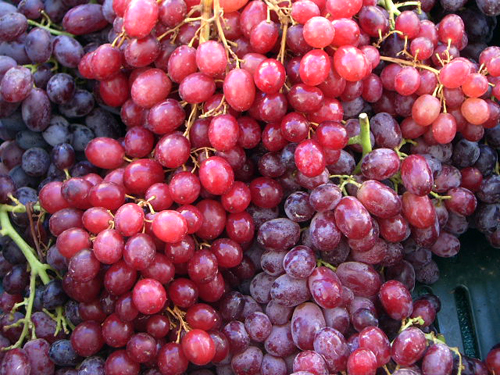
What do you eat when the grapes are ripe? Well, if you're surrounded by vineyards in northern Italy, you take your grapes and make a merenda, a snack, by pressing them into focaccia dough, sprinkling on olive oil, sugar, maybe a little anise seed, and baking the whole thing puffy and golden. And you call it schiacciata d'uva, which translates, appropriately enough, as "squashed grape thing."
But what if you can't get to Italy this autumn? While I was living in New York City, I discovered schiacciata d'uva on the fall menu at the Sullivan Street Bakery, along with a bunch of other rustic Italian-inspired breads and pastries. I'd walk 8 blocks from my office in Hell's Kitchen to get a slice in a paper bag, then eat all of it on the way back, wiping olive oil from my fingers as I went and wishing I'd bought two.
Spring, summer, and winter, I'd make the same walk for a slice of their Roman-style, thin-crust pizzas, topped with mushrooms or celery root, radicchio or potato. And they were good, but fall's grape flatbread was spectacular: pockets of juicy sweetness nestled into chewy, yeasty crust and crumb, accented by the surprising, subtly medicinal-herbal scent of anise.
Last time I checked, we had a lot of grapes growing around here. What with all the slick Italian pizza joints around, you'd think we'd be rolling in grape-topped foccacia right about now. But nope: just as New York City has no Indian pizza, San Francisco has no schiacciata d'uva, as far as I've been able to discover. But, you have yeast, you have grapes, you have flour, sugar, a little anise seed and an inch or so of last night's white wine, and you can make your own.
This recipe began from the Focaccia from Genoa recipe in Carol Field's cookbook Focaccia: Simple Breads from the Italian Oven, further adapted by baker/blogger Jen McAllister, then messed around with in my own kitchen. Jen, who became a friend while we were both living the sweet outer-borough life in NYC (she in Queens, me in Brooklyn), wrote one of my favorite blogs, Prepare to Meet Your Bakerina. We shared a similar obsession with making bread, cake, jam, and pie, and an equal enthusiasm for the late Laurie Colwin, out-of-print British cookbooks, and the Writers' Colony at Dairy Hollow in Arkansas, where we both did fellowships.